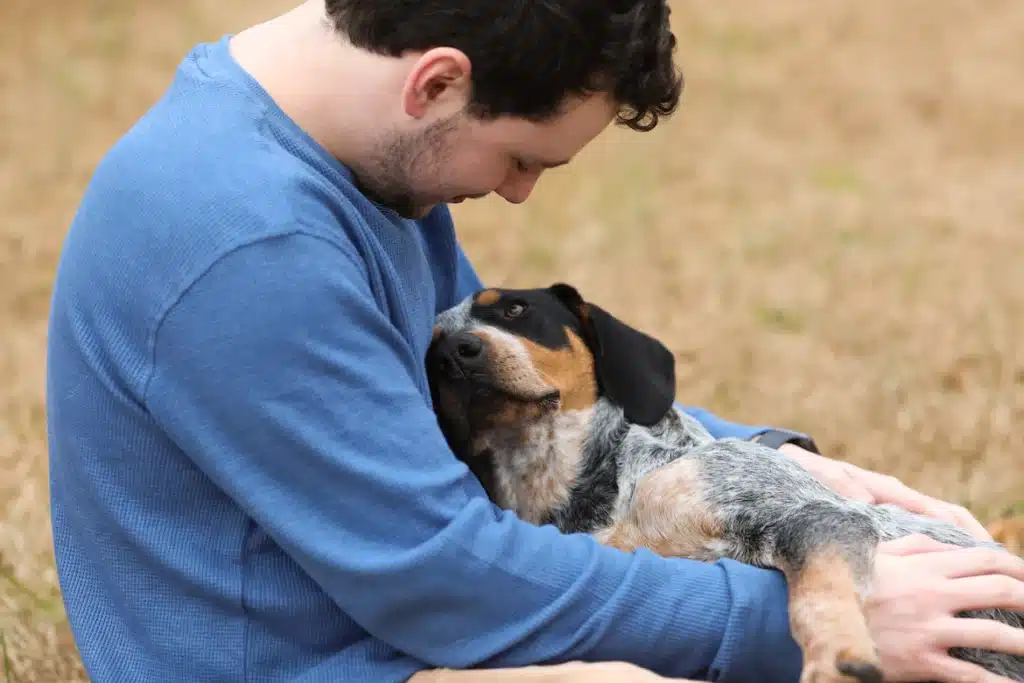Canine empathy is a fascinating aspect of dog behavior that reveals the profound bond between humans and their four-legged companions. Recent dog research has provided insights into how dogs interpret our emotions and respond with remarkable sensitivity. For example, studies utilizing dog MRI scans have shown that certain brain activities are triggered when dogs witness their owners in distress, indicating an innate capacity for empathy. This unique canine behavior not only strengthens the human-dog bond but also enriches our understanding of their emotional intelligence. As researchers like Erin Hecht from Harvard continue to investigate, the concept of canine empathy remains a key focus in unraveling the complexities of our relationship with dogs.
The emotional responsiveness of dogs, often referred to as their emotional intelligence, has garnered interest in various fields, including psychology and anthropology. This natural ability for understanding human feelings and situations highlights the intricate connections within the human-animal companionship. Researchers are delving into canine behavior, especially through advanced techniques like brain imaging, to uncover how dogs perceive and react to human emotions. Such exploration not only sheds light on the evolutionary traits that make dogs suitable as companions but also enhances the framework of the human-pet dynamic that has enriched many lives. With ongoing studies into these interactions, the discourse on the nature of empathy in dogs continues to evolve.
Understanding Canine Empathy Through Behavior
Canine empathy is a captivating aspect of dog behavior that has garnered attention in recent dog research. Studies have shown that dogs possess an uncanny ability to sense human emotions, often responding in ways that demonstrate their understanding. For instance, when humans display signs of distress or pain, many dogs instinctively react with comforting behaviors such as licking or staying close. This reaction illustrates not just the bond between humans and dogs but also highlights the emotional intelligence that many canine companions exhibit. Such behaviors are observable in countless interactions, revealing a profound layer to the human-dog bond.
Research conducted in laboratories, including the notable studies at Harvard’s Canine Brains Lab, aims to quantify this empathy through controlled experiments. Erin Hecht, a prominent figure in canine research, utilizes advanced tools like MRI scans to observe how dogs’ brains respond to various stimuli and emotional expressions from humans. In her studies, differences among breeds and their innate capacity for empathy are explored, providing valuable insights into the evolutionary aspects of canine behavior. By examining these elements, we gain a better understanding of why dogs are often referred to as ‘man’s best friend’, showcasing their evolved characteristics that facilitate their roles in human society.
The Science Behind the Human-Dog Bond
The human-dog bond is not merely a product of companionship; it has deep biological roots that intertwine our lives with those of our canine friends. Research indicates that through centuries of domestication, dogs have evolved to become attuned to human social cues, enhancing their ability to form strong attachments. This bond is further supported by studies using dog MRI scans, which reveal neural pathways in dogs that are responsive to human interaction, underscoring the biological basis of our relationship with them. As Erin Hecht points out in her research, the connection we share with dogs is both emotional and cognitive, reflecting their unique position in our lives.
Moreover, the bond between humans and dogs is reciprocal in nature. On one hand, dogs gain companionship, protection, and care from humans; on the other, humans receive unconditional love, loyalty, and joy from their dogs. This interdependent relationship has been highlighted in the works of researchers like Hecht, who emphasize that understanding canine behavior can lead to stronger and healthier relationships. For example, dogs trained to assist people with disabilities highlight how the bond can extend beyond emotional support, showcasing the practical benefits of this partnership. The resilience of the human-dog bond is evident in various studies, which reflect that these animals have become an integral part of our lives and communities.
The Role of Photography in Capturing Canine Behavior
Photography plays a significant role in understanding canine behavior, particularly through the lens of social media and photographers like Elias Weiss Friedman, known for his work on ‘The Dogist’. By capturing genuine moments and expressions of dogs, photography not only showcases their beauty but also aids in illustrating the depth of their emotions. Through Friedman’s extensive collection of dog portraits, audiences are given a glimpse into the unique personalities of individual dogs, allowing for a more profound appreciation of their behavior and emotional nuances. This visual storytelling fosters a culture of empathy and understanding around dogs, making their experiences relatable to a wider audience.
Moreover, the synergy between visual arts and canine research can enhance our understanding of dog-human interactions. Photographers can highlight specific behaviors that researchers may study further, creating a feedback loop between art and science. Such collaborations can prompt innovative research questions and engage the public in important discussions about canine welfare and behavior. By visualizing the emotional expressions of dogs, photographers contribute not only to the artistic community but also to the realm of scientific inquiry, showcasing an invaluable intersection that enriches our appreciation for our furry companions.
Exploring Canine Behavior Through MRIs
The advent of technology such as MRI scans has revolutionized our understanding of canine behavior by providing insights into what goes on inside a dog’s brain. Researchers like Erin Hecht utilize these scans to explore different behavioral traits associated with various breeds. For instance, assessments can reveal the brain’s responses to fear, aggression, and even loyalty, offering a glimpse into how these traits are developed and manifested. By understanding the neurological underpinnings of canine behavior, scientists can better address behavioral issues and improve training methods, ultimately enriching the lives of both dogs and their owners.
In addition to behavioral analysis, the application of MRI technology has also opened new avenues for studying the cognitive abilities of dogs. By investigating how different breeds process information and respond to stimuli, researchers can assess their learning capabilities and adaptability. This research not only highlights the diversity of cognitive skills present in canine species but also provides invaluable information for dog owners and trainers. Such knowledge can lead to personalized training approaches and better care strategies, promoting a healthier and more fulfilling relationship with our canine companions.
The Cultural Impact of Dogs in Society
Dogs have long been celebrated in arts and culture, serving as symbols of loyalty, companionship, and love. From literature to films, the presence of dogs often evokes powerful emotions and reflects societal values surrounding friendship and fidelity. The relationship between humans and dogs has been beautifully portrayed throughout history, emphasizing their roles beyond animals and more as vital members of our families. With social media platforms like Instagram amplifying these representations, the ‘dog culture’ has evolved, connecting dog lovers worldwide and fostering a community centered around appreciation and advocacy for canine rights.
Moreover, this cultural appreciation extends into various philanthropic efforts aimed at improving the welfare of dogs. Increased awareness about dog adoption and rescue initiatives has surged, with many organizations leveraging social media to disseminate information and share heartwarming stories. This movement demonstrates the collective power of dog lovers advocating for dogs in need, showcasing the profound influence that our furry friends have on human lives. By participating in these cultural narratives, we acknowledge the critical role dogs play not only in our lives but also in shaping societal norms and values towards love and compassion.
The Evolutionary History of Dogs
The origins of the domestic dog can be traced back thousands of years, highlighting a rich evolutionary history that has shaped their behavior and characteristics today. Genetic research suggests that dogs descended from wolves approximately 20,000 to 40,000 years ago, during which time they began their journey alongside humans. This long-standing relationship necessitated adaptations that favored traits such as sociability, loyalty, and emotional sensitivity, which are crucial in forming the strong bonds dogs share with humans. Understanding this evolutionary background provides context for the diverse range of canine behaviors we observe today.
As dogs have adapted to various human roles, from hunting partners to beloved family pets, their evolutionary journey has resulted in distinct breed characteristics. Different breeds were developed based on specific human needs, leading to specialized skills and temperaments. With this diversity comes a range of behaviors that researchers like Erin Hecht strive to understand through scientific inquiry. By exploring the historical functions of breeds, we can appreciate the rich tapestry of the dog species and how it reflects the evolving expectations and interactions between dogs and humans throughout history.
Canine Behavior: Insights from Field Studies
Field studies on canine behavior provide crucial insights into how dogs interact with their environment and humans in natural settings. These studies often reveal patterns of behavior that can differ significantly from the controlled conditions of a lab. Observing dogs in their day-to-day lives allows researchers to comprehend the complexities of their social interactions, play patterns, and communication styles. Erin Hecht emphasizes the importance of these studies, as they contribute to a holistic understanding of the factors influencing dog behavior, ultimately helping owners foster better relationships with their pets.
The findings from field studies also serve as a bridge between theory and practice, informing dog training and welfare practices. By recognizing how different breeds communicate, express emotions, and engage socially, trainers can adapt their methods to align with natural instincts. This approach not only enhances the learning experience for dogs but also strengthens the bond between pets and their owners. As researchers continue to conduct field studies, the knowledge gained will undoubtedly play a vital role in shaping the future of canine care and training practices, fostering a deeper understanding of our furry friends.
Community Engagement Through Canine Companions
Canine companions serve as powerful tools for community engagement and social interaction. As noted by Elias Weiss Friedman, dogs act as ‘furry icebreakers’, helping people forge connections in their neighborhoods. Walking a dog often leads to casual encounters with fellow dog owners, enhancing social ties and building community. The shared experience of dog ownership creates a sense of belonging and camaraderie among individuals, fostering relationships that might not have developed otherwise. This communal aspect of dog ownership highlights the significant role dogs play in enhancing our social fabric.
Moreover, therapy dogs and service animals exemplify how dogs contribute to social well-being by enriching the lives of individuals with disabilities or emotional challenges. Programs that integrate therapy dogs into educational and healthcare settings demonstrate the healing power of dogs, fostering positive interactions that facilitate emotional support and empathy. As communities increasingly recognize the importance of these partnerships, there is a growing effort to incorporate dogs into social programs aimed at enhancing connectivity and support amongst individuals. In this way, dogs not only provide companionship but also improve collective mental health and social cohesion.
Engaging the Next Generation of Dog Researchers
As the field of canine research continues to grow, engaging young scholars and dog lovers alike is essential for the future of dog studies. By encouraging children and their families to participate in research like those conducted at Harvard, we can inspire a new generation of researchers who are passionate about understanding canine behavior. Initiatives that involve young dog owners and their pets not only advance scientific knowledge but also foster a sense of responsibility and care for animals among youth. This involvement can spark interest in science and contribute to a lifelong appreciation for dogs and their well-being.
Additionally, such outreach underlines the significance of the human-dog bond that forms early in life, influencing how children perceive and interact with animals. Programs that integrate educational experiences with hands-on research encourage empathy and respect towards all animals. By connecting young minds with canine research, we can cultivate future advocates for dog welfare and conservation efforts, ensuring that our understanding of these remarkable creatures evolves alongside their needs in an increasingly complex world.
Frequently Asked Questions
What is canine empathy and how is it studied?
Canine empathy refers to the ability of dogs to understand and respond to the emotions of humans and other dogs. Researchers like Erin Hecht at Harvard use various methods, including dog MRI scans, to study canine behavior and empathy. This research helps uncover how dogs perceive human emotions, with some dogs showing remarkable responses during tests designed to measure their empathy.
How do researchers use dog MRI scans to understand canine empathy?
Dog MRI scans are utilized by scientists to visualize brain activity in response to human emotions, shedding light on canine empathy. By examining neural responses, researchers can identify emotional signatures in dogs, helping to explain their ability to bond with humans and react empathetically in various situations.
What role does the human-dog bond play in canine empathy?
The human-dog bond is foundational to canine empathy, as dogs have evolved alongside humans to become our social partners. This bond enhances a dog’s ability to recognize and respond to human emotions, making them empathetic companions who can sense our feelings and react accordingly.
Can all dogs demonstrate empathy, or is it breed-specific?
While many dogs exhibit empathy, responses can vary significantly between breeds and individual dogs. Certain breeds have been selected over time for traits that enhance their social interaction and emotional intelligence, which contributes to their ability to display empathetic behavior.
What are some signs that a dog is empathizing with its owner?
Signs of canine empathy include a dog responding to their owner’s emotional cues, such as comforting them when they are sad or distressed, touching them gently, or attentively watching their behavior. Research has shown that dogs can discern emotional signals, enhancing their ability to empathize with their humans.
Canine behavior studies reveal insights about dog empathy over time?
Yes, studies on canine behavior reveal that dogs may develop empathy through various experiences, including positive interactions with humans and other dogs. Longitudinal studies help researchers understand how empathy evolves in dogs, influenced by factors like socialization and training.
Are there any notable findings from Harvard’s canine empathy research?
Harvard’s canine empathy research has revealed significant variability in how dogs understand and respond to human emotions. One study highlighted that some dogs would take action, such as removing an object that seems dangerous or responding to human pain cues by providing comfort, showcasing their empathetic abilities.
How can pet owners foster empathy in their dogs?
Pet owners can foster empathy in their dogs by encouraging social interactions, providing positive reinforcement during emotional exchanges, and engaging in activities that enhance the bond, such as training and play. This helps develop a dog’s social cognition and emotional intelligence.
| Key Points |
|---|
| Erin Hecht studies canine brains using MRIs to understand dog emotions and behaviors. |
| Elias Weiss Friedman captures candid moments of dogs, showcasing their honesty and expressions as a photographer for ‘The Dogist.’ |
| Studies are exploring dog empathy, community engagement, and how dogs form bonds with humans. |
| Canine bonds are significant, with dogs being social partners for humans and contributing to community connections. |
| Research includes engaging dogs with behavioral issues linked to early life stress and also studying human-child-dog dynamics. |
Summary
Canine empathy plays a vital role in the relationship between dogs and humans. Through studies conducted at Harvard, researchers have uncovered the profound emotional connections dogs share with people. The research highlights how dogs respond to human emotions and their capacity to empathize, further emphasizing the importance of the human-canine bond.



